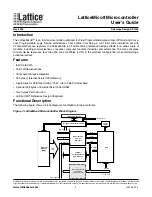
NOVA electronics Inc.
MCX514 -
91
-
91
-
2.9
Timer
MCX514 is equipped with one timer in each axis
, which can set with the range of 1 ~ 2,147,483,647μsec in increments of 1μsec
(at CLK = 16MHz).
By using with synchronous action, various operations which combine a motor drive and timer functions can be performed
precisely. The followings are some of examples.
■
After the termination of driving, driving starts after the elapse of a specified time.
V
Time
V
Time
Timer
Termination of driving
Start of driving
After 17.35 msecs
Fig. 2.9-1 Example 1 of Timer Operation
■
Designated drive pulses are output with a specified time period correctly.
1. 000
ms
Drive Pulse
1. 000
ms
1. 000
ms
Fig. 2.9-2 Example 2 of Timer Operation
■
Performs decelerating stop after driving at constant speed for a specified time in acceleration/deceleration driving.
500K
Speed
(pps)
Acceleration
Constant Speed 10.00msec
Start Deceleration
Time
Fig. 2.9-3 Example 3 of Timer Operation
2.9.1 Timer Operation
MCX514 has a 31-bit length timer counter. When a timer is started, it counts up
from 0 in increments of 1μsec, and when the
count reaches the value specified by the timer value (the time is up), then the timer stops. When the operation mode of a timer is
set to “once”, the timer operation is finished when the timer expires. When the operation mode of a timer is set to “repeat”, the
count starts to count up from 0 again after the timer expires. And it repeats the operation unless the timer is stopped by timer-stop
command or a synchronous action.
Expiring of a timer can be set as the activation factor of a synchronous action, and various operations such as the start of driving
or output of an external signal can be performed. For more details of the synchronous action, see chapter 2.6.
In addition, when a timer expires, the user can generate an interrupt signal and so it is possible to perform the operation in
synchronization with the CPU.














































